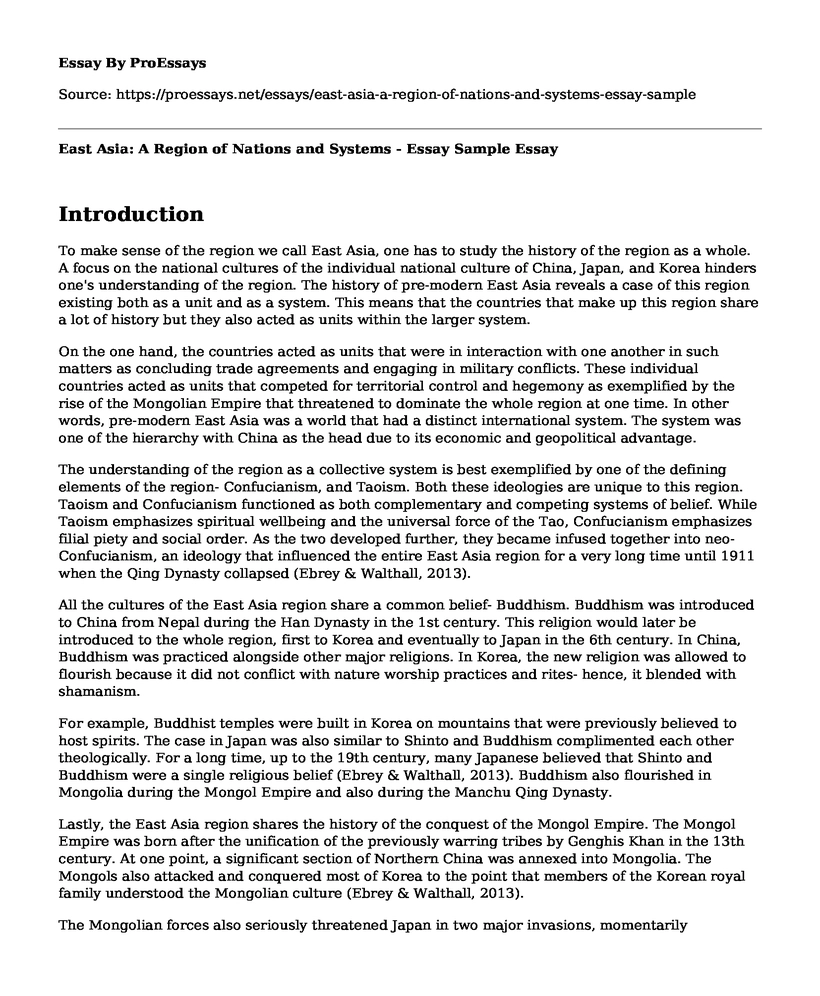Introduction
To make sense of the region we call East Asia, one has to study the history of the region as a whole. A focus on the national cultures of the individual national culture of China, Japan, and Korea hinders one's understanding of the region. The history of pre-modern East Asia reveals a case of this region existing both as a unit and as a system. This means that the countries that make up this region share a lot of history but they also acted as units within the larger system.
On the one hand, the countries acted as units that were in interaction with one another in such matters as concluding trade agreements and engaging in military conflicts. These individual countries acted as units that competed for territorial control and hegemony as exemplified by the rise of the Mongolian Empire that threatened to dominate the whole region at one time. In other words, pre-modern East Asia was a world that had a distinct international system. The system was one of the hierarchy with China as the head due to its economic and geopolitical advantage.
The understanding of the region as a collective system is best exemplified by one of the defining elements of the region- Confucianism, and Taoism. Both these ideologies are unique to this region. Taoism and Confucianism functioned as both complementary and competing systems of belief. While Taoism emphasizes spiritual wellbeing and the universal force of the Tao, Confucianism emphasizes filial piety and social order. As the two developed further, they became infused together into neo-Confucianism, an ideology that influenced the entire East Asia region for a very long time until 1911 when the Qing Dynasty collapsed (Ebrey & Walthall, 2013).
All the cultures of the East Asia region share a common belief- Buddhism. Buddhism was introduced to China from Nepal during the Han Dynasty in the 1st century. This religion would later be introduced to the whole region, first to Korea and eventually to Japan in the 6th century. In China, Buddhism was practiced alongside other major religions. In Korea, the new religion was allowed to flourish because it did not conflict with nature worship practices and rites- hence, it blended with shamanism.
For example, Buddhist temples were built in Korea on mountains that were previously believed to host spirits. The case in Japan was also similar to Shinto and Buddhism complimented each other theologically. For a long time, up to the 19th century, many Japanese believed that Shinto and Buddhism were a single religious belief (Ebrey & Walthall, 2013). Buddhism also flourished in Mongolia during the Mongol Empire and also during the Manchu Qing Dynasty.
Lastly, the East Asia region shares the history of the conquest of the Mongol Empire. The Mongol Empire was born after the unification of the previously warring tribes by Genghis Khan in the 13th century. At one point, a significant section of Northern China was annexed into Mongolia. The Mongols also attacked and conquered most of Korea to the point that members of the Korean royal family understood the Mongolian culture (Ebrey & Walthall, 2013).
The Mongolian forces also seriously threatened Japan in two major invasions, momentarily occupying the city of Kitakyushu. As observed, the history of pre-modern East Asia is a shared history and a focus on national cultures hinders our understanding of the region. As a result, the understanding of the individual national cultures is not essential to making sense of the region we call East Asia.
Reference
Ebrey, P. B., & Walthall, A. (2013). Pre-Modern East Asia: A Cultural, Social, and Political History, Volume I: To 1800. New York: Cengage Learning.
Cite this page
East Asia: A Region of Nations and Systems - Essay Sample. (2023, Mar 17). Retrieved from https://proessays.net/essays/east-asia-a-region-of-nations-and-systems-essay-sample
If you are the original author of this essay and no longer wish to have it published on the ProEssays website, please click below to request its removal:
- A Policy Brief: Maternal Health in Rural Africa
- Paper Example on Tuberculosis in Canada
- Paper Example on Balancing China's Effects on Climatic Damages Risks
- Chushingura's Women and Family Essay
- Paper Example on Prescribing Opioids in US: Dentists Lead the Way
- Families in US & Japan: Caring & High Divorce Rates - Essay Sample
- Free Report Sample on Education SWIRL & Professional Development







